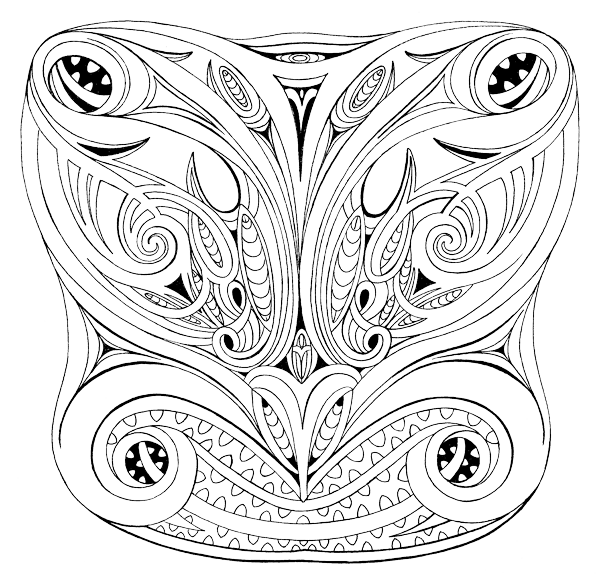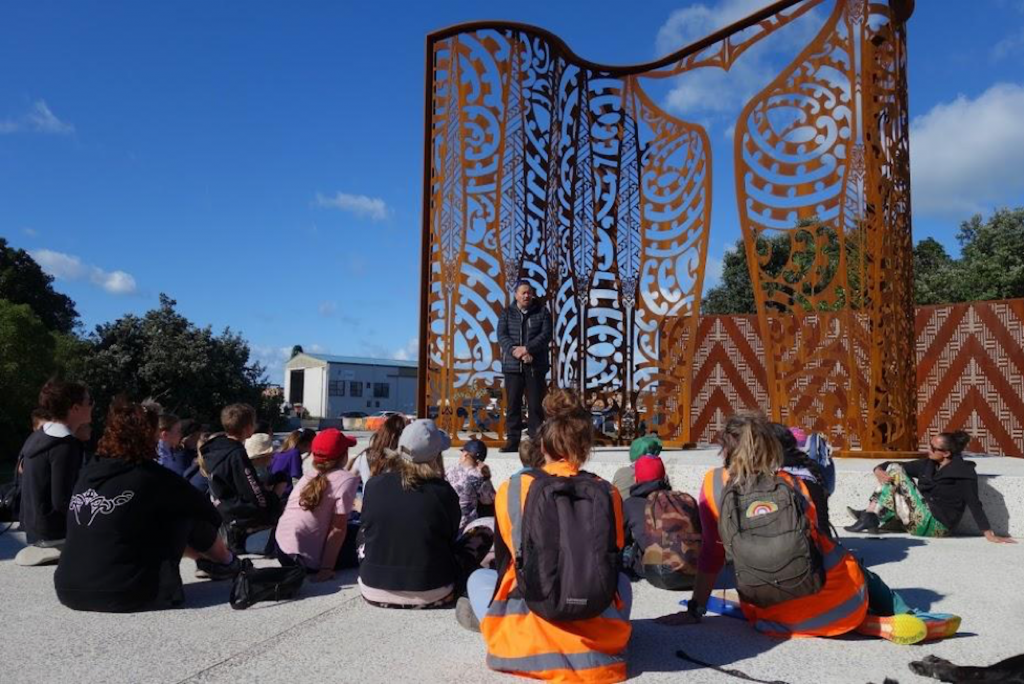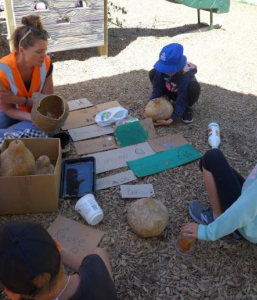
Hine Moana represents qualities of female aspects of the sea.
When we started planning a hui that addressed rethinking waste from a Māori perspective, we were challenged to make it authentic for our young learners. Working with Ngati Oneone, mana whenua to Titirangi maunga enabled the engagement of tamariki through a kaupapa Māori lens, and deepened connections to local stories and tikanga.
The day that eventuated on Titirangi was place-based, linked to examples of traditional Māori living, gardening, and cooking, and created very little waste, while considering the choices we make each day.
Our mihi whakatau from Uncle Albie from Ngāti Oneone was very special as he shared the stories of Maia bringing hue to Tūranganui-a-Kiwa and Te Maro, the legendary gardener, growing kai for his people. This pūrākau related to the amazing new sculptures at Puhi Kai Iti and on Titirangi.

The students, representing seven schools, journeyed into the present day by examining the Seabin and storm water grate at the harbour. The Seabin is emptied a few times a day as it filters out mostly plastic waste from the surface of the harbour.
The stormwater grate had a coke can and more plastic trapped in it. Students could see the links between how plastic travels via Tāwhirimātea (wind) and Tangaroa (water) and how these atua are affected by modern waste.
Schools were encouraged to stop waste entering their own school stormwater drains and to design some funky art creating awareness in their school and expressing why it’s important to keep waste out of Tangaroa. Eastland Port and Gisborne District Council were excellent at extending their support to this kaupapa.

Students learn about the Seabin and its purpose of filtering waste from the harbour water.
After a brief weather flurry, we moved to a midden site where Jordan and Mihi from Whaia Titirangi (a collaborative programme between Ngati Oneone and Gisborne District Council) shared their knowledge and mahi. Jordan and Mihi work full-time on the maunga, planting native trees, weeding and spraying, education, looking after pest control and more!
They are passionate people who relate well to our students and teachers. We loved collaborating with them, and they were kind enough to help plan the whole day.
Looking into the midden site gave students a tangible window into the past and was fascinating to all of us. We heard about the Polynesian designed fishhook made of moa bone that was found at the port, indicating it was made in the pre-1300s.
This taonga contrasted vividly to the “modern midden” that was observed on the path – full of plastic, dumped bones and cans washed off the road. This gave the students an opportunity to reflect upon their learning of the day so far, and the difference between the ‘old and the new’ ways of living.

Observing shells in the small midden pit on Titirangi.
Jordan explained that as well as demonstrating the tikanga around harvesting kawakawa for rongoā Māori, the students were also given a kōrero about the small midden pit which had shell remains present on Titirangi. “This gave a good comparison to what early Māori cooks left after a kai, where-as we in the modern era have a kitchen rubbish bin full of plastic, tin cans and other non-biodegradable items”.
After a delicious morning tea, we moved into groups and explored the different ways we can reduce waste. Talei from Te Wānanga o Aotearoa discussed the whakapapa and tikanga of harvesting harakeke and our students loved making a putiputi.

How does plastic affect Atua?
Rawinia Kingi, Poutautoko from Te Aho Tū Roa, helped us plan the day and ran an inspiring workshop about the story of how kūmara came to Tairāwhiti and how we can grow it. Enviroschools Tairāwhiti Regional Coordinator Darnelle Timbs challenged students with a story of plastic and the affects plastic waste this can have on many Atua.
We finished the day by each writing down one idea for moving towards zero waste in our own lifestyles. We then sowed our ideas, by literally planting a hue seed in a pot. Schools discovered more about the stories around hue and how to grow containers from hue instead of using plastic.
Finally, we honoured the learning from the day by closing with our poroporoaki, which was given by Mihi.
It turned out the enthusiasm from the day’s learning wasn’t over however, and the interesting kōrero continued on the journey home. Emma McFadgyen, teacher at Makauri School, said that during the drive back the students discussed how they were going to facilitate specific workshops in their collaborative hub to share with others what they had learnt on this day.
The students contemplated how this could lead to tidying up the school’s harakeke, growing a potential rongoā garden, and growing hue and kūmara.
“The recent Enviroschools workshop gave students an opportunity to view zero waste through a kaupapa Māori lens. It incorporated the local history of the Tairāwhiti region and weaved these ideas to our present time and how we can look at reducing our waste currently. The students, who attended the day from the school I work at, were engaged during the whole process and found the experiences relevant to the projects they were exploring in their school, which they will take back and share as inspiration… It was a great day!” – Emma McFadgyen
